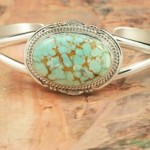Native American Navajo Tribe
The Navajo lived in what is now northwestern New Mexico and northeastern Arizona and were a nomadic group of people until they came into contact with the Pueblo
by Donna Bunnell • October 01, 2017

Habitat
The Navajo lived in what is now northwestern New Mexico and northeastern Arizona. This land contained peaks, grasslands, deserts, and canyons. The Navajo were a nomadic group of people until they came into contact with the Pueblo. They adopted some of the beliefs and customs of the Pueblo including farming, making pottery, and weaving.
Homes
The Navajo lived in homes called hogans. Hogans were round houses built with forkedsticks. The sticks were covered with brush, packed earth, hides, and whatever wasavailable. The front door of the hogan always faced east to catch the first light of themorning sun. Later the Navajo built a six-sided hogan of logs and mud. The hogan alwayshad only one room. Some had tables, chairs, beds, and wood-burning stoves. Outside thehome a loom for weaving was set up. It was brought indoors only in the winter. A corral for the herd of sheep was close by the hogan. Homes were far apart from each other. The Navajo blessed their homes in a special ceremony to bring it good luck and happiness.
The Navajo make their clothing from deerskin. The men wore breechcloths and leggings. The women wore deerskin dresses. Both wore moccasins. After the 1800’s the Navajo men borrowed the style of the Mexicans and wore blankets draped over one shoulder. Their pants ended halfway between their knees and ankles. They decorated the seams of their pants with silver buttons. The women also borrowed the Mexican style of dressing. The women wore woolen dresses made with two blankets stitched together at their shoulders. The women carried their babies in cradle boards, sometimes strapped to their backs. Later the women traded for calico and made big, full skirts.
Traditional women would wear a traditional dress made of cotton material, having three to four tears in the skirt. Her shirt is typically made of velvet or crushed velvet adorned with coin buttons. She will also wear two types of traditional belts, either at the same time or one at a time. That decision is usually made based on the type of event or reason for dressing traditional. The first belt is a woven belt is named “sash belt”, the second, a leather belt, which is worn on top of the sash; this is called a concho belt. The women have no head dresses, rather a Navajo bun positioned on the back of the head.
A traditional man would wear cotton pants, a concho belt, and velvet or crushed velvet shirt. A man and wife will usually wear matching outfits. The only traditional head dress worn is worn by a man. Aside from the Navajo bun, positioned in the back of the head, there would be a scarf, folded to make a long thin (belt looking) scarf. This would be tied above one ear.
Food
The Navajo were primarily hunters and trappers. They hunted deer, pronghorn antelope, and rabbits. Later they became farmers and sheep raisers. The grew watermelons, corn, beans, and squash. They also gathered wild plants, seeds, roots, and berries.
Customs
The Navajo believed in many gods. The most powerful god was Sun Bearer and one of his wives, Changing Women. The land of the Navajo was marked off by four sacred mountains: white mountains, turquoise blue mountain, yellow mountain, and jet black mountain.
The sand painting was constructed on the floor of the hogan by sifting various powdered herbs, sand and other powdery material. The sick person was given a special herb to drink and told to sit in the center of the dry painting. The shaman touched the head of the figure then touched the patient’s had and chanted. This was repeated with each part of the body. The sand painting was removed before sundown and buried beneath trees that stood to the north, south, east, and west of the hogan. If the patient died his/her body was taken out a new door broken through the north side of the hogan and burned.
Around 1600 the Navajo women began to spin and weave wool. The sheep belonged to the women and the horses belonged to the men. The women sheared the sheep. Navajo women learned from the Pueblo how to weave. The early rugs they made were usually striped straight across. Later the women learned to weave a stripe on a slant and to make a diamond shaped design. The first rugs the Navajo made were dyed with leaves, berries, and insects. The frame of the loom was made of four long poles and set up outdoors except in the winter. The rug or blanket was never wholly completed or perfect because the Navajos believed it would offend the spirits.
Silversmithing
The Navajo started silverwork in the late 1800’s. First they hammered Spanish and Mexican coins into silver buttons. The buttons were sewn onto their clothing and cut off when money was needed. After the Treaty of 1868 the Navajo people were given specialized tools for silver smiting. After this they began making jewelry with turquoise stones. Turquoise Jewelry

